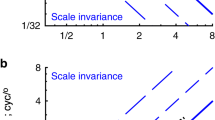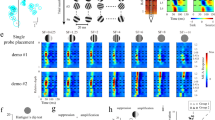Abstract
We address how spatial frequency selectivity arises in Macaque primary visual cortex (V1) by simulating V1 with a large-scale network model consisting of O(104) excitatory and inhibitory integrate-and-fire neurons with realistic synaptic conductances. The new model introduces variability of the widths of subregions in V1 neuron receptive fields. As a consequence different model V1 neurons prefer different spatial frequencies. The model cortex has distributions of spatial frequency selectivity and of preference that resemble experimental findings from the real V1. Two main sources of spatial frequency selectivity in the model are the spatial arrangement of feedforward excitation, and cortical nonlinear suppression, a result of cortical inhibition.












Similar content being viewed by others
References
Bardy, C., Huang, J. Y., Wang, C., FitzGibbon, T., & Dreher, B. (2006). ‘Simplification’ of responses of complex cells in cat striate cortex: Suppressive surrounds and ‘feedback’ inactivation. Journal of Physiology, 574, 731–750.
Beierlein, M., Gibson, J. R., & Connors, B. W. (2003). Two dynamically distinct inhibitory networks in layer 4 of the neocortex. Journal of Neurophysiology, 90, 2987–3000.
Bredfeldt, C. E., & Ringach, D. L. (2002). Dynamics of spatial frequency tuning in macaque V1. Journal of Neuroscience, 22, 1976–1984.
Cai, D., Tao, L., Shelley, M., & McLaughlin, D. (2004). An effective kinetic representation of fluctuation-driven neuronal networks with application to simple and complex cells in visual cortex. Proceedings of the National Academy of Science of the United States of America, 101, 7757–7762.
Campbell, F. W., Cooper, G. F., & Enroth-Cugell, C. (1969). The spatial selectivity of the visual cells of the cat. Journal of Physiology, 203, 223–235.
Chance, F. S., Nelson, S. B., & Abbott, L. F. (1999). Complex cells as cortically amplified simple cells. Nature Neuroscience, 2(3), 277–282.
Dayan, P., & Abbott, L. (2001). Theoretical neuroscience. Cambridge: MIT.
DeAngelis, G., Ohzawa, I., & Freeman, R. D. (1995). Receptive-field dynamics in the central visual pathways. Trends in Neuroscience, 18, 451–458.
DeAngelis, G. C., Ghose, G. M., Ohzawa, I., & Freeman, R. D. (1999). Functional micro-organization of primary visual cortex: Receptive field analysis of nearby neurons. Journal of Neuroscience, 19, 4046–4064.
Derrington, A. M., & Lennie, P. (1984). Spatial and temporal contrast sensitivities of neurones in lateral geniculate nucleus of macaque. Journal of Physiology, 357, 219–240.
DeValois, R. L., Albrecht, D. G., & Thorell, L. G. (1982). Spatial frequency selectivity of cells in macaque cortex. Vision Research, 22, 545–549.
DeValois, R. L., & DeValois, K. K. (1988). Spatial vision. New York: Oxford University Press.
Enroth-Cugell, C., & Robson, J. (1966). The contrast sensitivity of retinal ganglion cells of the cat. Journal of Physiology, 187, 517–552.
Finn, I. M., Priebe, N. J., & Ferster, D. (2007). The emergence of contrast-invariant orientation tuning in simple cells of cat visual cortex. Neuron, 54, 137–152.
Gibson, J., Beierlein, M., & Connors, B. (1999). Two networks of electrically coupled inhibitory neurons in neocortex. Nature, 402, 75–79.
Holmgren, C., Harkany, T., Svennenfors, B., & Zilberter, Y. (2003). Pyramidal cell communication within local networks in layer 2/3 of rat neocortex. Journal of Physiology, 551, 139–153.
Hubel, D. H., & Wiesel, T. N. (1962). Receptive fields, binocular interaction and function architecture in the cat’s visual cortex. Journal of Physiology, 160, 106–154.
Issa, N. P., Trepel, C., & Stryker, M. P. (2000). Spatial frequency maps in cat visual cortex. Journal of Neuroscience, 20, 8504–8514.
Koch, C. (1999). Biophysics of computation. Oxford: Oxford University Press.
Kuffler, S. K. (1953). Discharge patterns and functional organization of mammalian retina. Journal of Neurophysiology, 16, 37–68.
Lauritzen, T. Z., & Miller, K. D. (2003). Different roles for simple-cell and complex-cell inhibition in V1. Journal of Neuroscience, 23(32), 10201–10213.
McLaughlin, D., Shapley, R., Shelley, M., & Wielaard, J. (2000). A neuronal network model of sharpening and dynamics of orientation tuning in an input layer of macaque primary visual cortex. Proceedings of the National Academy of Science of the United States of America, 97, 8087–8092.
Mechler, F., & Ringach, D. L. (2002). On the classification of simple and complex cells. Vision Research, 42, 1017–1033.
Movshon, J. A., Thompson, I. D., & Tolhurst, D. J. (1978). Spatial and temporal contrast sensitivity of neurons in areas 17 and 18 of the cat’s visual cortex. Journal of Physiology, 283, 101–120.
Murthy, A., & Humphrey, A. L. (1999). Inhibitory contributions to spatiotemporal receptive-field structure and direction selectivity in simple cells of cat area 17. Journal of Neurophysiology, 81, 1212–1224.
Priebe, N. J., Mechler, F., Carandini, M., & Ferster, D. (2004). The contribution of spike threshold to the dichotomy of cortical simple and complex cells. Nature Neuroscience, 7, 1113–1122.
Ringach, D. L. (2002). Spatial structure and symmetry of simple-cell receptive fields in macaque primary visual cortex. Journal of Neurophysiology, 88, 455–463.
Ringach, D. L., Shapley, R. M., & Hawken, M. J. (2002a). Orientation selectivity in macaque V1: Diversity and laminar dependence. Journal of Neuroscience, 22(13), 5639–5651.
Ringach, D. L., Bredfeldt, C. E., Hawken, M., & Shapley, R. (2002b). Suppression of neural responses to non-optimal stimuli correlates with tuning selectivity in macaque V1. Journal of Neurophysiology, 87, 1018–1027.
Robson, J. G. (1975). Receptive fields. In K. DeValois & R. DeValois (Eds.), “Seeing” handbook of perception. New York: Academic.
Rodieck, R. W. (1965). Quantitative analysis of cat retinal gangalion cell response to visual stimuli. Vision Research, 5, 583–601.
Sato, H., Katsuyama, N., Tamura, H., Hata, Y., & Tsumoto, T. (1996). Mechanisms underlying orientation selectivity of neurons in the primary visual cortex of the macaque. Journal of Physiology, 494, 757–771.
Shelley, M., McLaughlin, D., Shapley, R., & Wielaard, J. (2002). States of high conductance in a large-scale model of the visual cortex. Journal of Computational Neuroscience, 13, 93–109.
Sirovich, L. & Uglesich, R. (2004). The organization of orientation and spatial frequency in primary visual cortex. Proceedings of the National Academy of Science of the United States of America, 101, 16941–16946.
Tao, L., Shelley, M., McLaughlin, D., & Shapley, R. (2004). An egalitarian network model for the emergence of simple and complex cells in visual cortex. Proceedings of the National Academy of Science of the United States of America, 101(1), 366–371.
Tao, L., Cai, D., McLaughlin, D., Shelley, M., & Shapley, R. (2006). Orientation selectivity in visual cortex by fluctuation-controlled criticality. Proceedings of the National Academy of Science of the United States of America, 103, 12911–12916.
Troyer, T. W., Krukowski, A. E., Priebe, N. J., & Miller, K. D. (1998). Contrast-invariant orientation tuning in cat visual cortex: Thalamocortical input tuning and correlation-based intracortical connectivity. Journal of Neuroscience, 18, 5908–5927.
von der Heydt, R., Peterhans, E., & Dsteler, M. R. (1992). Periodic-pattern-selective cells in monkey visual cortex. Journal of Neuroscience, 12, 1416–1434.
Wielaard, D. J., Shelley, M., McLaughlin, D., & Shapley, R. (2001). How simple cells are made in a nonlinear network model of the visual cortex. Journal of Neuroscience, 21, 5203–5211.
Xing, D., Ringach, D., Shapley, R., & Hawken, M. (2004). Correlation of local and global orientation and spatial frequency tuning in macaque V1. Journal of Physiology, 557, 923–933.
Yoshimura, Y., & Callaway, E. M. (2005). Fine-scale specificity of cortical networks depends on inhibitory cell type and connectivity. Nature Neuroscience, 8, 1552–1559.
Acknowledgements
This work was supported by a grant from the Swartz Foundation, and by grants from the National Eye Institute R01EY-01472 and T32EY-07158. Thanks to Drs. Dajun Xing, Patrick Williams, and Chun-I Yeh for helpful comments on the manuscript.
Author information
Authors and Affiliations
Corresponding author
Additional information
Action Editor: Jonathan D. Victor
Rights and permissions
About this article
Cite this article
Zhu, W., Shelley, M. & Shapley, R. A neuronal network model of primary visual cortex explains spatial frequency selectivity. J Comput Neurosci 26, 271–287 (2009). https://doi.org/10.1007/s10827-008-0110-x
Received:
Revised:
Accepted:
Published:
Issue Date:
DOI: https://doi.org/10.1007/s10827-008-0110-x




